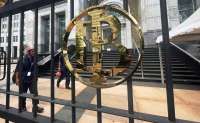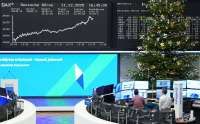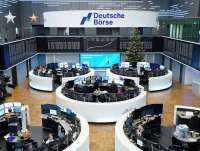GLOBAL ECONOMY - WASHINGTON. The number of Americans filing new claims for unemployment benefits rose moderately last week, showing no signs yet that tightening credit conditions were having a material impact on the tight labor market.
But the risks to the economy are mounting. Other data on Thursday showed corporate profits in the fourth quarter declining by the most in five years, in part because of penalties and fines imposed on several businesses. That included a $1.7 billion civil penalty against Wells Fargo for what the government said was to "settle allegations that it illegally assessed fees and interest charges on auto and car loans."
"The song remains the same for the labor market," said Conrad DeQuadros, senior economic advisor at Brean Capital in New York. "Layoffs remain at very low levels and the labor market remains extremely tight."
Initial claims for state unemployment benefits increased 7,000 to a seasonally adjusted 198,000 for the week ended March 25, the Labor Department said. Economists polled by Reuters had forecast 196,000 claims for the latest week. Claims have stayed low despite high-profile layoffs in the technology industry.
Economists attributed the low level in claims partly to seasonal adjustment factors, the model that the government uses to strip out seasonal fluctuations from the data, which they said could have been affected by the COVID-19 pandemic.
Read Also: Fed's Collins Leans Toward One More Rate Hike Then Hold for Rest of Year
The Labor Department said seasonal factors for initial and the so-called continuing claims for 2023 as well as updated factors for 2018 through 2022 would be available next Thursday. It will also publish revisions to both data series for that period on the same day.
Unadjusted claims rose 10,906 to 223,913 last week. There was a surge in claims in Michigan and big rises in California, Massachusetts, New York, Texas, Missouri and the District of Columbia. Applications fell significantly in Indiana.
With 1.9 job openings for every unemployed person in January, employers have generally been reluctant to let go of workers, and laid-off workers could be easily finding new employment. But tightening lending standards following the recent collapse of two regional banks could make it harder for households and small businesses to access credit, potentially dampening demand for labor.
According to an analysis by Goldman Sachs, leisure and hospitality and other service industries rely heavily on bank lending.
"Over the last six months, these two industries account for half of the plus 150,000 average overshoot in nonfarm payroll growth relative to its pre-pandemic average pace," said Spencer Hill, an economist at Goldman Sachs. "We expect slowing job growth in this sector as diminished loan availability dissuades restaurant operators and other smaller businesses from hiring new workers and opening new establishments."
Stocks on Wall Street were trading higher. The dollar fell against a basket of currencies. U.S. Treasury prices were mixed.
Read Also: Ford, Vale Indonesia, Huayou Sign Deal for US$ 4.5 Billion EV Battery Material Plant
ECONOMY VULNERABLE
The Federal Reserve last week raised its benchmark overnight interest rate by a quarter of a percentage point, but indicated it was on the verge of pausing further increases in borrowing costs in a nod to the financial market turmoil. The U.S. central bank has hiked its policy rate by 475 basis points since last March from the near-zero level to the current 4.75%-5.00% range.
The number of people receiving benefits after an initial week of aid, a proxy for hiring, rose 4,000 to 1.689 million during the week ending March 18. These continuing claims covered the period during which the government surveyed households for the unemployment rate for March.
Continuing claims increased moderately between the February and March survey weeks. The unemployment rate was at 3.6% in February. Labor market resilience is underpinning the economy, though clouds are gathering.
In a report on Thursday, the Commerce Department confirmed the economy grew at a solid clip in the fourth quarter, but much of the increase in output came from inventory accumulation that was mostly unplanned.
Gross domestic product increased at a revised 2.6% annualized rate last quarter, the government said in its third estimate of fourth-quarter GDP. That was revised down from the 2.7% pace reported last month, and reflected downgrades to exports and consumer spending on services.
There were upward revisions to nonresidential fixed investment, residential and state and local government spending. Estimates for the rate of growth for the first quarter are currently as high as 3.2%.
Read Also: FCC Proposes Rules to Reassess Foreign-Owned US Telecom Services Authority
Goods-producing industries logged a 4.0% growth rate, outperforming the 2.3% pace of expansion in the services-producing sector. Seventeen out of 22 industries contributed to GDP growth, led by professional, scientific and technical services. There also were boosts from retail trade, durable goods manufacturing and mining. But finance and insurance, real estate and rental and leasing as well as construction acted as drags.
National after-tax profits without inventory valuation and capital consumption adjustments, conceptually most similar to S&P 500 profits, dropped $169.5 billion in the fourth quarter, or at a 5.9% rate. That was the largest decline in dollar terms since the fourth quarter of 2017. Profits were down 1.4% on a year-on-year basis.
In addition to Wells Fargo, Glencore International AG agreed to pay approximately $316 million in penalties and fines for paying bribes to officials in multiple countries.
Domestic nonfinancial profits also fell, which economists said could affect employment.
When measured from the income side, the economy contracted at a 1.1% rate in the last quarter, the worst performance since the second quarter of 2020. Gross domestic income (GDI) increased at a rate of 2.8% in the third quarter. The income side of the growth ledger was not impacted by the fines.
The average of GDP and GDI, also referred to as gross domestic output and considered a better measure of economic activity, increased at a 0.7% rate in the October-December period, slowing from a 3.0% growth pace in the third quarter.
"The average of GDP and GDI tends to be a leading indicator," said Oren Klachkin, lead U.S. economist at Oxford Economics in New York. "This suggests that the economy is vulnerable."
/2017/08/06/1495258855p.jpg)









